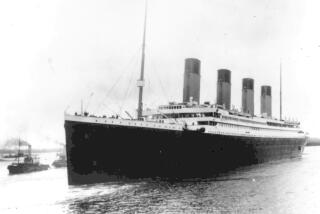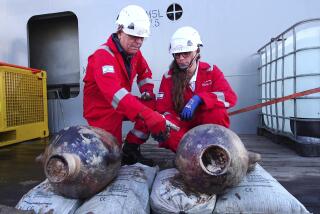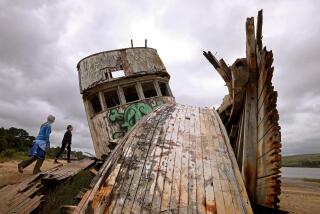Shipwreck a Prize for Archeologists
PENSACOLA, Fla. — The wreck of a 50-gun Spanish frigate in Pensacola Bay is giving marine archeologists a rare look at a ship built in the New World three centuries ago.
Most vessels they have been able to examine from that era are of European origin. The Nuestra Senora del Rosario, however, was built in Mexico only about five years before it sank during a storm in 1705.
The ship seems to have been privately built and then purchased by the Spanish government, said John Bratten, who is overseeing excavation work on the wreck for the University of West Florida Archeology Institute.
During each of the last four summers, archeologists and students have uncovered bits of the ship in shallow water near Civil War-era Ft. Pickens on Santa Rosa Island. The vessel is estimated to be about 120 feet long.
State archeologists located the Rosario in 1992 under tons of silt. For six years, however, it took a back seat to an older wreck of a Spanish galleon in another part of the bay.
Known as the Emanuel Point wreck, the galleon sank in 1559, when Pensacola was first settled by Europeans, making it the oldest shipwreck found in Florida waters. The galleon, part of an expedition led by Tristan de Luna, was partly excavated and artifacts, including a huge iron anchor, were removed before it was reburied in 1997.
The Luna colony lasted two years before being abandoned. The Spanish returned in 1698 to establish a military outpost known as Presidio Santa Maria de Galve.
The Rosario brought payroll and supplies to the presidio from Mexico and Cuba but sank before loading a cargo of lumber for Mexico. It would have been one of first such shipments from Pensacola, a forerunner of a booming timber industry in the Florida Panhandle.
The crew tried to save the storm-tossed ship by putting out five anchors and cutting off a mast, but it ran aground and broke up, according to historic documents.
The Rosario is made from types of mahogany and Spanish cedar that grow only around the coastal state of Veracruz.
“We don’t see this in a European ship,” Bratten said. “We’re not sure what to call this.”
On a European ship, the same section would have been made of many parts instead of a single, massive piece of wood.
“In Europe, they harvested so much timber from the forest that the large trees were gone,” Bratten said. Here, he said, they use the large pieces of timber to mold into use on various parts of the ship.
The Spanish salvaged much of the Rosario’s equipment, including its cannons, but hundreds of artifacts remained for archeologists to find nearly 300 years later.
Among them: wooden pulleys, a box filled with iron nails, an unarmed hand grenade, a cannonball, a brass ring, glass bottles, pipe stems, weights and floats for fishing nets, animal bones and a variety of ceramic objects such as olive jars.
The Emanuel Point wreck was used as a summer field school for nautical archeology students. When that work was done, the researchers relocated the Rosario and put it to the same use.
The university last year obtained a $300,000 grant from the Department of State’s Division of Historic Preservation to continue the Rosario excavation. The university also was getting help from the Navy until the Sept. 11 terrorist attacks.
The Navy’s Coastal Systems Station at Panama City Beach had loaned the university a 46-foot pontoon boat, normally used for mine-detection work. Researchers, however, were denied access to Pensacola Naval Air Station, where the boat was docked, in the days immediately after the attacks.
“This fall we got a little work done, but not what we wanted to do,” Bratten said.
Excavation was put on hold until an old barge used for the Emanuel Point wreck was refurbished and then moored at the Rosario site.
Archeologists initially planned to suspend work for the year after Thanksgiving, but they continued into December, as the weather remained mild, to make up for some of the lost time. The excavation will resume with another field school this summer.
More to Read
Sign up for Essential California
The most important California stories and recommendations in your inbox every morning.
You may occasionally receive promotional content from the Los Angeles Times.










